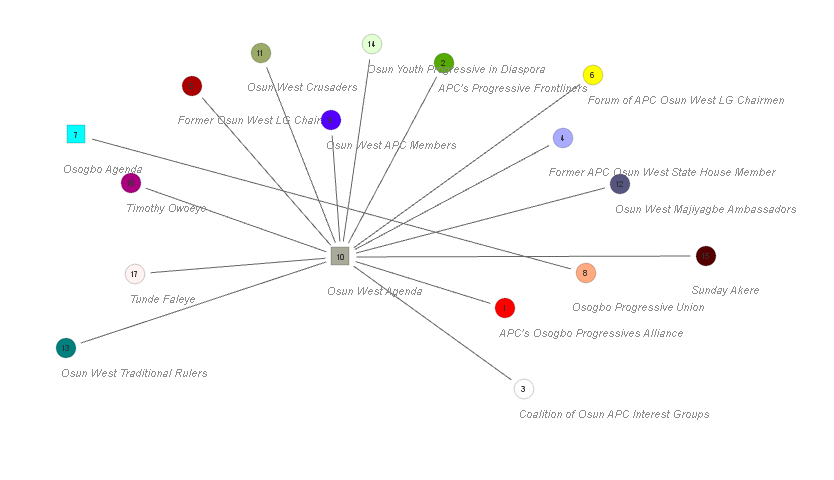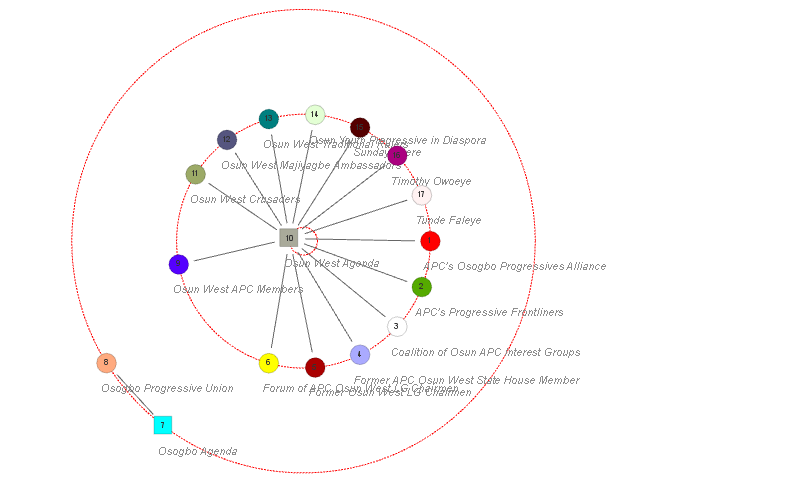
A new dynamic is quietly reshaping the political landscape ahead of Osun 2026 governorship election. While public attention still gravitates toward familiar party leaders and traditional power blocs, the real story lies beneath the surface. The ongoing political conversations and coalition-building efforts suggest a significant shift in influence. At the heart of this shift is not a single politician, but an emerging force known simply as the Osun West Agenda.
Osun West Agenda is not a person but a coordinated activity that now dominates the political discourse in the state. It stands out not only for its prominence but also for how deeply connected it has become to various actors and groups. When compared to the rest of the political ecosystem, Osun West Agenda commands the highest level of engagement and attention. This places it far ahead of many other movements and actors that have long enjoyed visibility in Osun politics.
Exhibit 1: Osogbo vs. Osun West Agenda network ahead of Osun 2026 election
Register for Tekedia Mini-MBA edition 19 (Feb 9 – May 2, 2026): big discounts for early bird.
Tekedia AI in Business Masterclass opens registrations.
Join Tekedia Capital Syndicate and co-invest in great global startups.
Register for Tekedia AI Lab: From Technical Design to Deployment (next edition begins Jan 24 2026).

By contrast, the Osogbo Agenda, another initiative built around political identity and regional interest, appears to be losing steam. Despite Osogbo’s historical significance and its role as the capital of the state, the activities associated with the Osogbo Agenda are barely registering among key political influencers. The limited reach of this movement suggests that Osogbo’s traditional dominance is being challenged, not just in words but in action.
To understand this development, we must consider the actors rallying around each movement. Osun West Agenda enjoys broad support from individuals and platforms that stretch across political and regional divides. Some of the most active groups behind it include the Osun West APC Members, Osun West Crusaders, Osun West Majiyagbe Ambassadors, and Osun West Traditional Rulers. These groups have strong grassroots connections and are closely aligned with other influential political actors across the state.
Backing these platforms are several well-established individuals and interest groups. These include the Former APC Osun West State House Members, the Former Osun West Local Government Chairmen, and the Forum of APC Osun West Local Government Chairmen. Their long-standing involvement in party structures gives them both credibility and access. Their alignment with the Osun West Agenda is helping to propel it into the center of strategic conversations about 2026.
Exhibit 2: Who has proximity prestige among the actors

Notably, other statewide figures are also involved in shaping the pre-election narrative. Actors such as Sunday Akere, Timothy Owoeye, and Tunde Faleye continue to hold considerable influence. These individuals are part of a broader group of APC-affiliated leaders who include the Coalition of Osun APC Interest Groups, the APC’s Progressive Frontliners, and the APC’s Osogbo Progressives Alliance. Together, they represent a core group that continues to drive political decisions within the party, though not always from the spotlight.
Interestingly, while these leaders and groups remain active and interconnected, their attention is increasingly being drawn toward the Osun West narrative. Rather than initiating their own agendas, they are lending credibility and energy to a movement that already seems to be leading the conversation. This shift reflects a growing belief that Osun West, long underrepresented in the state’s highest offices, may finally be positioned to take the lead.
In stark contrast, platforms connected to the Osogbo Agenda such as the Osogbo Progressive Union and related cultural or civic networks are operating at the margins. Their ideas are not being picked up widely, and their calls for attention are not resonating beyond their immediate circles. While their loyalty to the Osogbo cause is clear, they are currently unable to translate that commitment into political capital.
This changing balance of influence is not just about geography. It speaks to a larger political recalibration. Osun West Agenda is being embraced because it speaks to a broader desire for equity and inclusion. It has become a banner for those seeking new leadership, new opportunities, and a reset of old expectations. It is also seen as a unifying platform that can appeal to a broad coalition of groups who feel underrepresented.
Our analyst notes that as stakeholders look toward the primaries and eventual campaigns, those who want to be serious contenders in 2026 must find a way to align with the momentum coming from the West. This is not simply a matter of political calculation. It reflects a genuine shift in where the energy and ambition of Osun politics now reside.
The path to victory in 2026 will not be paved by legacy alone. It will depend on who listens, who adapts, and who chooses to build bridges rather than rely on old maps. In this race, the Osun West Agenda is not just a passenger. It is in the driver’s seat.



